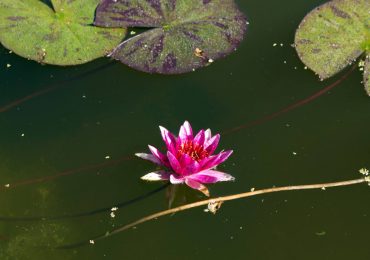
Water gardening provides one more way for gardeners to add plants to their environment. Selecting these aquatic plants requires the same thoughts and elements as regular garden plants.
How much light will the plant receive? “The sunnier the spot, the better” is a good rule to follow, but there are aquatics suitable for shade and partial shade. Where is the plant going to be growing? And, what purpose is the plant going to fulfill? Deciding on the plant will be determined by container size or whether it will be in a pond with a liner, a natural pond or in some other type of water-holding environment.
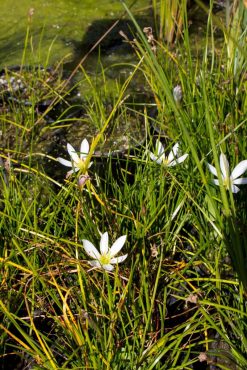
Tips for Selecting Aquatic Plants
Jan Bahr at Roadhouse Nursery says that when plants are small, it’s hard to tell what size they’ll become at maturity. She also explains that plants will grow to suit the size of the container. An exception is water lilies. Water lily pots must be completely submerged in water, with the stems growing up to the surface, where the leaves emerge and the flowers bloom.
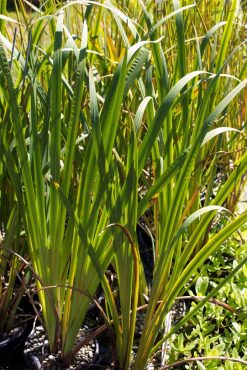
Look for named varieties because they grow truer to size. For small water gardens, plant tags may say pygmy or dwarf — a good indicator of being diminutive — but labels don’t always list all the details.
“Ask a reputable nursery staff person for advice on plant size,” Bahr says.
Most aquatic garden plants have three planting zones: fully submerged plants in pots on the bottom; middle zone plants requiring some water coverage, with foliage emerging through the top of the water; and plants along the top and edges, with wet feet but most of the foliage outside the water feature. One last category is floating plants such as water lettuce and azolla (a tiny floating fern).
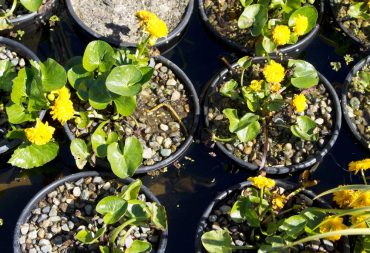
Water garden plants include annuals, perennials, evergreens, grasses, bulbs and rhizomes. They require periodic maintenance, thinning and dividing. The plants are potted into soil that most often contains clay and is heavier than regular potting soil. Plants may also require fertilizer at planting time and then periodically, depending on their individual growth needs. Fertilizer is usually in tablet form, inserted at potting time.
“Most aquatic plants (like any garden plants in containers) will need to be fertilized. There are fertilizers specifically formulated for aquatic plants that will not harm the fish or promote excessive algae growth in the pond,” Bahr says.
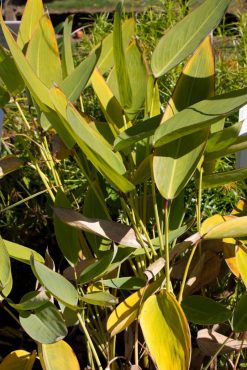
She doesn’t recommend ordering online or via mail.
“You have to be so very, very careful of bringing an invasive species into the natural environment here,” she says.
Consult the Washington State Department of Agriculture and U.S. Department of Agriculture website links in this article for lists of invasive plants. It’s a good idea to look at the invasive plant lists from other states because it provides a good idea of how rapidly growing and invasive a plant can become. Yellow flag iris and some varieties of elodea are examples of extremely invasive plants that have taken over lakes, streams and even some salt water areas in West Sound.
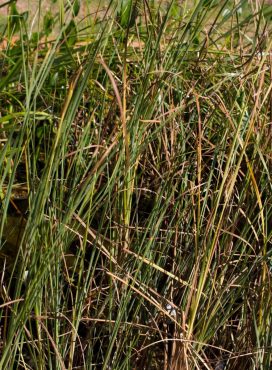
“Do not put plants out in nature if you decide you no longer want to water garden,” says Bahr, explaining that well-meaning people just can’t stand to destroy or dispose of a plant, so they release it out into the natural environment. Doing so is a very bad idea and very bad for the native plants ecosystems.
“You could be introducing the next noxious weed problem,” she says. Always dispose of unwanted plants in the garbage or compost them.
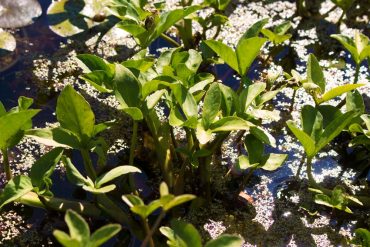
Also be cautious when choosing plants for earthen bottom lakes and ponds.
“Always consult with a knowledgeable nursery person about the potential invasiveness of the plant selected. Based upon that, make a careful decision,” Bahr says.
She welcomes questions and is happy to assist gardeners in plant selections.
“Remember, aquatic plants are in a container inside of a water-filled container. What you select and how you care for it will depend on the effect you’re wanting to make,” she says.
Gardeners have made mistakes in plant selection or changed their tastes through time. Water gardening is no exception.
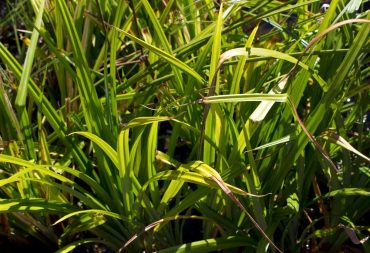
“Sometimes you just need to experiment and discover what works for you,” Bahr says.
Containers and Ponds
Containers can vary from quite small (room for one plant) up to bathtub size. Remember to select containers that will not break when water expands as it freezes or when low temperatures can cause the container to crack and split.
Galvanized containers, depending on the galvanizing process, can be toxic to fish. It is best to avoid putting fish in these containers. When adding fish to any container, wait a few days or up to two weeks before introducing them to their new environment. In other words, let the plants settle in first and then add the fish.
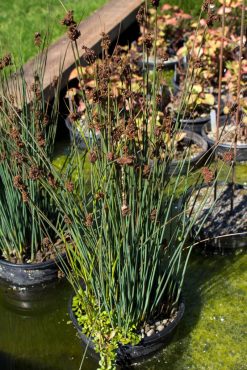
Many plants can overwinter right where they’re planted. For containers that need winter storage, decide where to keep the fish and what to do with the plants. Water lilies can be stored in water-filled tubs or buckets in a garage or storage area where they will not freeze. Check periodically to make sure the potted water lilies are always submerged in water.
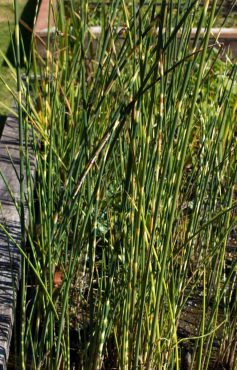
Seasonal Tips
Below are some tips from Bahr and from Roadhouse Nursery’s website.
Spring: Late winter and early spring are the times to clean any debris from the pond. Clean out leaves, blossoms and organic debris. Use a fine mesh net or a pond vacuum designed for water gardening.
If the pond has a biological filter, leave the pump running during winter. Also clean the filter in late winter or early spring. April is the time to fertilize aquatic plants. Follow label directions.
Summer: This is the time to repot or divide your water plants. Visit the Roadhouse Nursery website for handouts on “Cultivating Aquatic Plants” and “Cultivating Hardy Water Lilies.” Fertilize the water lilies again in July.
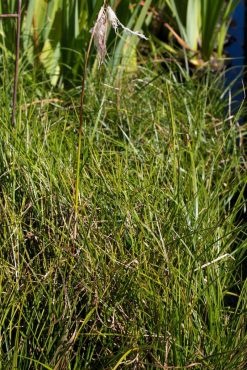
Eriophorum angustifolium
Remove old blossoms and foliage from water plants on a regular basis to save time on cleanup in the fall. Water lily aphids can be a problem this time of year. Hose them off the leaves with a spray nozzle or use an approved and safe aphid spray.
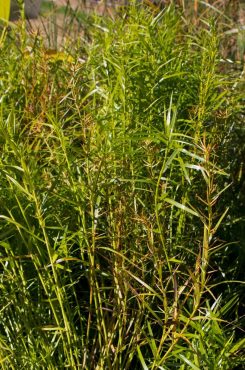
Add water to pond and container features as needed. A pond can lose one-half to one inch of water per day due to evaporation, depending on the temperature.
Fall: Start feeding fish less and switch to a spring and fall fish food around mid-September. Stop feeding fish when the water temperature drops below 50 degrees (around late October).
Clean leaves and other debris from the pond. If there are a lot of deciduous trees and shrubs near the pond, consider putting a net over the pond to catch the leaves. Early November is a good time to clean biological filters.
Winter: This is the season to keep hands out of the cold water, if possible. If the pond ices over, don’t break the ice by hitting it. The concussion can harm fish.
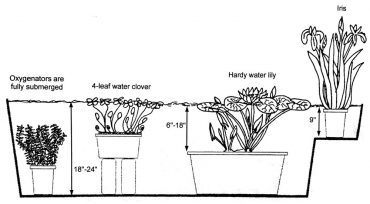
Use an electric pond heater or fill a gallon-sized milk jug half full of water, put the cap on and place it in the pond. Then lift the jug by the handle and break the ice without harming the fish. This is not necessary unless the pond is iced over for several weeks.
Normally fish will be fine unattended over the winter, which includes not feeding them. Plants will survive if they are hardy and were placed at the proper depth. Refer to “Cultivating Hardy Plants” on the Roadhouse website. If the water feature or pond has a pump, it will have to be turned off if the ice causes water to spill onto the ground.
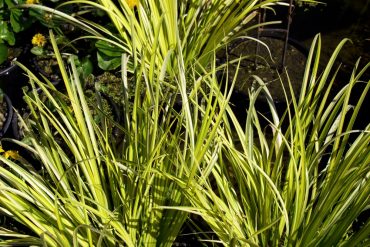
The Plants
A helpful handout on the Roadhouse Nursery website says, “Choose floating-leaf plants to cover one-half to two-thirds of the pond surface area. Some examples are water lily, four-leaf water clover and water hawthorn.
“Second, choose at least one bunch of submerged plants for every 10 square feet of pond surface area. Examples are hornwort and vallisneria. Third, add a few floating plants such as water hyacinth, water lettuce and frog bit to keep a pond healthy. These floating plants are annuals in West Sound but they are essential in maintaining good pond health. They also provide food and shelter for pond fish. Add fish to your pond two weeks after adding plants.”
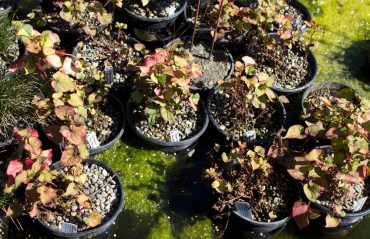
Container plantings can be as simple as one tall, impressive plant in a water-filled container or something larger, like a bathtub, filled to the brim with several different types of aquatic plants and a few fish. The only limit is the gardener’s budget and particular tastes of what plants provide appeal.
Remember that aquatic plant foliage ebbs and flows just as regular garden plant foliage does. Some aquatic plants bloom for long periods and others have bursts of blooms. Some have striking foliage and others provide soothing greenness and texture.




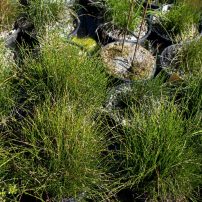
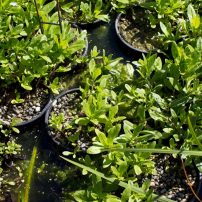
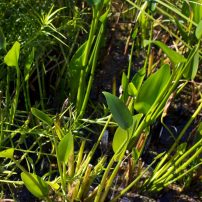
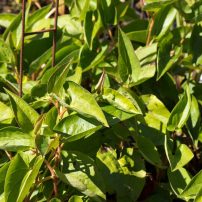
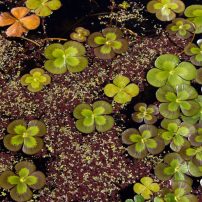
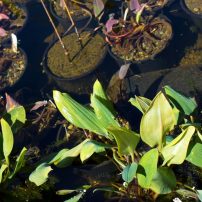

























Comments